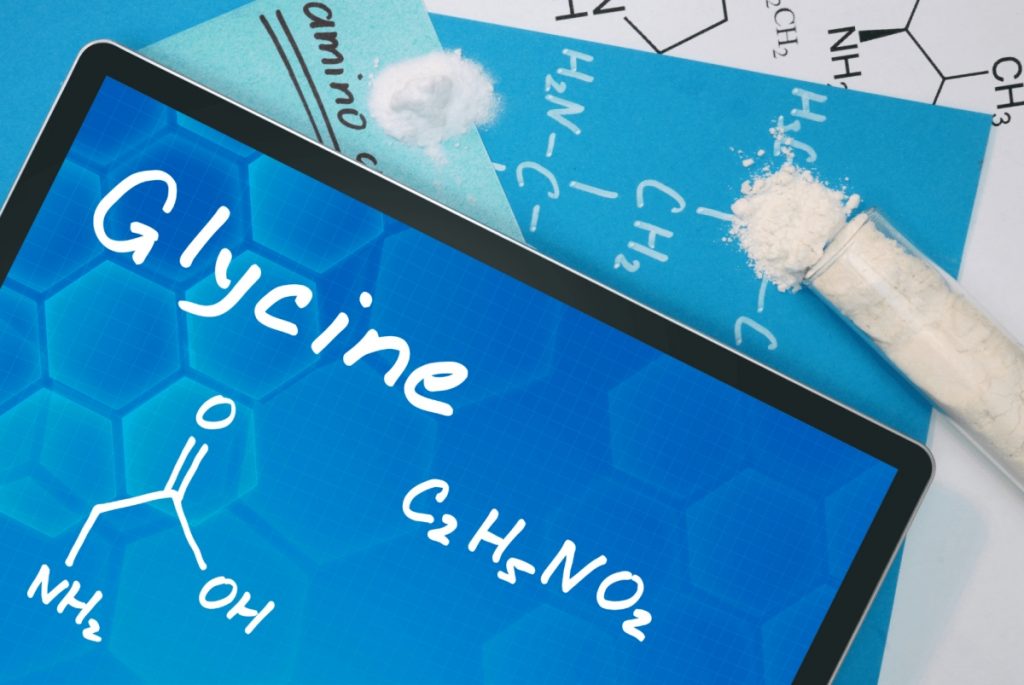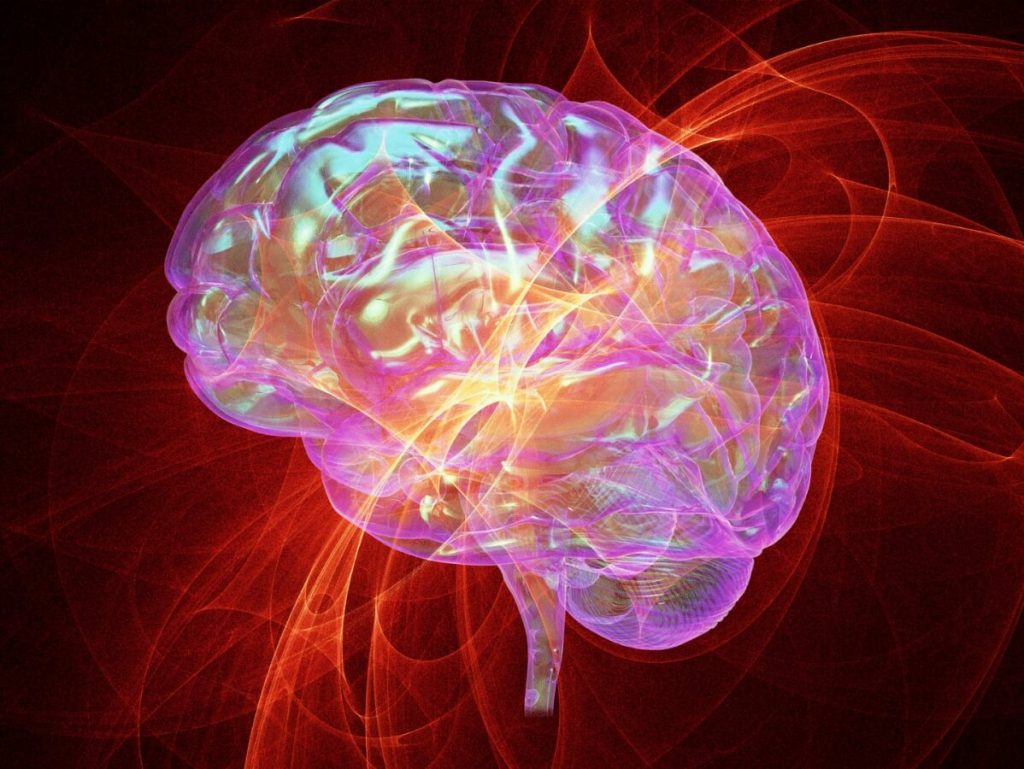Glycine is also a key ingredient for glutathione, making it crucial for detoxification and antioxidant defenses. In this article, we’ll cover everything you need to know about glycine and how to optimize its levels.
What Is Glycine?
Glycine is the simplest amino acid, with a slightly sweet taste. Fun fact: It got this name from the Greek word for sweet, which is ‘’glykys’’.
Glycine is a non-essential amino acid, which means your body can produce it. However, that means it’s so vital that our bodies can’t do without it. Every day, your body makes about 45 grams and you get about 3 – 5 grams of glycine from food. However, many people nowadays reap health benefits from consuming more glycine.

Pathways That Make Glycine In Your Body
Your body can produce glycine from:
- Serine
- Threonine
- And choline
Serine is also a nonessential amino acid, which comes from intermediate products of glycolysis (our carb burning pathway). Then, a specific mitochondrial enzyme turns serine into glycine.
Threonine is an essential amino acid, meaning that we have to get it from food. Our bodies can make glycine from threonine.
Lastly, choline is a chemical compound available in certain foods and as a supplement. Metabolism of choline into glycine releases methyl groups necessary for epigenetics and several other biochemical processes.
Roles Of Glycine In The Brain
Neurotransmitter
Glycine is a major inhibitory neurotransmitter that often works closely with GABA (especially in the brainstem and spinal cord) to fine-tune nerve impulses. It also modulates the excitatory functions of glutamate through NMDA receptors.
Glycine receptors (GlyRs) are widely present across the spinal cord, where they enhance the synaptic transmission and enable motor control. GlyRs are also present in hippocampus, brain cortex, cerebellum, and brainstem nuclei.
There are five different types of glycine receptor subunits:
- α1
- α2
- α3
- α4
- β
Usually two of them combine to work. The alphas can combine among each other or combine with the beta subunit.
Glycine neurotransmission requires transporters– specifically transporter 1 (GlyT1) and 2 (GlyT2). These transporters enable the reuptake of glycine from the synapse. GlyT1 occurs in glial cells, while GlyT2 occurs in neurons mostly.
Once glycine binds to glycine receptors, they quickly inhibit the receiving (postsynaptic) neurons in the brainstem and the spinal cord. These inhibitory effects can affect vision, hearing, and other sensory and motor functions.
Typically, nerve impulses happen by moving positive ions (sodium and potassium) in and out of neurons. When glycine binds to these receptors, an influx of negative chloride ions hyperpolarizes the cell, inhibiting neural transmission.
Sleep
Glycine also regulates some aspects of sleep, possibly through the suprachiasmatic nucleus and the body’s circadian clock.
In a rat study, injection and oral administration of glycine reduced core body temperature by increasing blood flow to the skin. Lower body temperature typically improves sleep.
In another rat study, glycine increased serotonin in the brain. Serotonin is a relaxing neurotransmitter and a precursor to melatonin. So, glycine may improve sleep by naturally supporting melatonin levels.
Glycine also improved sleep quality and relieved fatigue in healthy people with sleep deprivation. One study restricted 10 healthy male participants’ sleep to 25% less sleep than usual for 3 nights. Subjects received either 3 grams of glycine or a placebo. Subjects that received glycine doses had significantly lower daytime sleepiness and fatigue when compared to the control group.
Thus, glycine improves sleep and sleep quality, and it promotes relaxation by working as an inhibitory neurotransmitter.
This is one of the reasons glycine is a key ingredient in Sleep Breakthrough.

Memory And Cognition
Glutamate signaling through NMDA (N-methyl-D-aspartate) receptors is crucial for spatial memory, as well as learning. Your NMDA receptors go down with age, which might contribute to the age-related cognitive decline.
NMDA receptors depend a lot on glycine. Glycine, specifically, enhances NMDA transmission and slows desensitization within NMDA receptors.
A study involving students (average age around 20 years old) and men (average age around 58 years old) aimed to investigate the effects of glycine on attention, memory, and mood. Participants received Bioglycin, an active form of glycine.
Older men had significantly lower memory and attention than the student group. However, glycine improved memory in both groups, with limited effects on attention and focus.
These results occur via the NMDA receptors, which plays a role in the basis of learning and memory.
In a rat study, glycine helped with memory and cognitive enhancement after these were impaired with D-galactose.
The researchers divided 64 rats into 4 groups (16 mice per group):
- D-galactose for 60 days (100 mg/kg body weight)
- D-galactose and glycine for 60 days (1 g/kg body weight in 0.9% saline solution)
- Glycine for 60 days
- 0.9% saline solution for 60 days (control group)
D-galactose induced oxidative stress in the mice, which then threw off inflammation, damaged neurons, and impaired their memory.
Glycine inhibited these negative consequences of D-galactose because group 2 (D-galactose + glycine) had significantly better cognitive performance than group 1 (D-galactose only).
Glycine upregulates antioxidant proteins, memory-related presynaptic proteins (synaptophysin, syntaxin, postsynaptic density protein), and downregulates inflammatory proteins in these neurons.
There is no evidence that glycine can treat any brain diseases in humans currently. However, based on this study, glycine may help protect neurons, cognitive function, and memory from day-to-day oxidative stress.
Brain Development
Glycine receptors (GlyR) help your brain develop during embryonic development. For an immature central nervous system, glycine acts as an excitatory neurotransmitter which induces spontaneous activities in neural networks.
When you were in the womb, glycine enhanced the growth and maturation of:
- Neural circuits
- Hippocampus
- Brainstem nuclei
- Auditory system
- Spinal development
Information Processing
Glycine receptors participate in information processing– both motor and sensory. Generally, glycinergic receptors enable sensory pathways such as hearing and vision, but also movement.

Glycine Roles In Cells And The Body
NOTE: The diseases and disorders mentioned in the following text are complex, and glycine only takes part in these pathways. We are not suggesting that glycine or supplements that affect glycine levels can cure any disease.
Building Block Of Protein And Collagen
Glycine, being an amino acid, builds up proteins. Approximately 80% of available glycine goes towards protein synthesis.
Furthermore, glycine is one of the building blocks of collagen, the most abundant protein in your body. Glycine occurs at every third position in collagen, and keeps collagen helices together.
Glycine is also necessary for the production of:
- Heme: a protein that carries iron in your red blood cell
- Primary bile salts: helps break down fat droplets in your intestine
- Purines: a component of your DNA, ATP, and many other signaling molecules in your body
- Creatine: an amino acid crucial for strong bursts of energy production and cognitive function
As an amino acid building block for enzymes, glycine makes the active site of an enzyme more flexible. This is necessary to induce conformational changes during catalysis. This may make the enzyme more flexible for many different types of substrate.
Helps With Detoxification As Part Of Glutathione
Glycine is a building block of glutathione, along with cysteine and glutamate. Glutathione is a crucial antioxidant throughout your body, especially for liver detoxification.
Glycine protects the liver from certain toxins, especially alcohol. It slows down the stomach’s ability to empty itself of alcohol, which subsequently reduces damage due to alcohol to your body. Additionally, glycine reduces the levels of metabolic products of alcohol and lowers the negative effects of oxidative stress on the liver.
Protects The Stomach Lining And Gut Health
Extensive research supports the idea that glycine is cytoprotective and helps protect the stomach lining against stomach acid.
Glycine also manages cells and linings of the gastrointestinal tract. It protects the damaged gut cells from cell death (apoptosis). Also, glycine plays a role in regenerating the intestinal lining.
In the intestines, there are several membrane transport pathways which depend on glycine. In this case, glycine increases the uptake of nutrients by cells of the intestines. Furthermore, glycine can mitigate gut irritation and damage.
Promotes A Balanced Inflammatory Response
Glycine possesses several inflammation-balancing and immunomodulatory properties. For example, it inhibits macrophages, reducing their pro-inflammatory cytokine secretions.
Many types of white blood cells release their inflammatory substances through changes in the cell membrane and intracellular calcium levels. Glycine may modulate inflammation by stabilizing their cell membrane and increasing intracellular calcium level.
Glycine also acts on neutrophils and lymphocytes, resulting in immunomodulation.
Cardiovascular And Blood Sugar Benefits
People with obesity, heart health risk, nonalcoholic fatty liver disease, and insulin resistance/type 2 diabetes, tend to have lower plasma levels of glycine.
Glycine supports healthy insulin secretion and glucose tolerance. Glycine is not a cure for these conditions, but these studies indicate the importance of glycine for cardiovascular health, as well as physiological metabolic functions.
Muscles
Glycine stimulates mTOR signaling, which has muscle-building effects. As a precursor of creatine, it also prevents muscle loss.
What Happens When Glycine Levels Are Too Low Or Too High?

Glycine is so essential that excessive or true deficiencies are very rare. However, many people nowadays benefit from supplementing with glycine, since typical glycine consumption is low relative to other amino acids.
Physiological glycine levels range from 200 to 300 µmol/L. Low circulating levels of glycine correlate with several metabolic disorders:
- Non-alcoholic fatty liver disease. Patients diagnosed with this disease have 9-13% lower plasma glycine levels.
- Insulin resistance and diabetes. Plasma levels of glycine in obese individuals with insulin resistance or diabetes are 10% lower than the physiological value. Additionally, low glycine levels increase the risk of developing diabetes type 2.
- Oxidative stress. Glutathione is an antioxidant. Lower levels of glycine correlate with lower levels of glutathione, enhancing the consequences of oxidative stress.
On the other hand, when glycine is too high, other disorders might arise:
- Nonketotic hyperglycinemia. This is a genetic disorder which disables glycine breakdown. As a result, glycine accumulates primarily within the brain, resulting in neurological consequences.
- Stomach problems. If you take too much glycine, vomiting and nausea might occur.
How to Increase Your Glycine Levels
Food Rich In Glycine
The best way to naturally increase your glycine levels is to consume glycine-rich foods. Some of the options are:
- Meat, especially tougher cuts, tendons, and organ meats
- Fish
- Gelatin-rich Bone broth that gels when it cools down
- Dairy products
- Legumes
- Gelatin
Food Rich In Threonine
Since threonine is a glycine precursor, increasing your threonine levels can induce the same effects in glycine levels. Foods rich in threonine include:
- Eggs
- Meat
- Nuts
- Cheese
- Soybean
Glycine Supplements
You can get pure glycine as a powder that dissolves easily in water and has a natural sweet taste. If you take glycine as a capsule, it usually needs a lot (>3) of capsules, so it’s best to get a powder and dissolve it in water.
BiOptimizers Sleep Breakthrough contains glycine powder to support the best sleep.
Collagen Supplements
Glycine is the building block of collagen. Thus, using collagen supplements like Collagenius might also boost your glycine levels.
References:
- Gersovitz M, Bier D, Matthews D, Udall J, Munro HN, Young VR. Dynamic aspects of whole body glycine metabolism: influence of protein intake in young adult and elderly males. Metabolism. 1980;29(11):1087-1094. doi:10.1016/0026-0495(80)90220-6
- Razak MA, Begum PS, Viswanath B, Rajagopal S. Multifarious beneficial effect of nonessential amino acid, Glycine: A review. Oxid Med Cell Longev. 2017;2017:1716701. doi:10.1155/2017/1716701
- Bird MI, Nunn PB, Lord LA. Formation of glycine and aminoacetone from L-threonine by rat liver mitochondria. Biochim Biophys Acta. 1984;802(2):229-236. doi:10.1016/0304-4165(84)90166-1
- Erichsen L, Thimm C, Santourlidis S. Methyl group metabolism in differentiation, aging, and cancer. Int J Mol Sci. 2022;23(15):8378. doi:10.3390/ijms23158378
- López-Corcuera B, Geerlings A, Aragón C. Glycine neurotransmitter transporters: an update. Mol Membr Biol. 2001;18(1):13-20. doi:10.1080/09687680010028762
- Avila A, Nguyen L, Rigo JM. Glycine receptors and brain development. Front Cell Neurosci. 2013;7:184. doi:10.3389/fncel.2013.00184
- San Martín VP, Sazo A, Utreras E, Moraga-Cid G, Yévenes GE. Glycine receptor subtypes and their roles in nociception and chronic pain. Front Mol Neurosci. 2022;15:848642. doi:10.3389/fnmol.2022.848642
- Salceda R. Glycine neurotransmission: Its role in development. Front Neurosci. 2022;16:947563. doi:10.3389/fnins.2022.947563
- Dutertre S, Becker CM, Betz H. Inhibitory glycine receptors: an update. J Biol Chem. 2012;287(48):40216-40223. doi:10.1074/jbc.R112.408229
- Kawai N, Sakai N, Okuro M, et al. The sleep-promoting and hypothermic effects of glycine are mediated by NMDA receptors in the suprachiasmatic nucleus. Neuropsychopharmacology. 2015;40(6):1405-1416. doi:10.1038/npp.2014.326
- Bannai M, Kawai N, Nagao K, Nakano S, Matsuzawa D, Shimizu E. Oral administration of glycine increases extracellular serotonin but not dopamine in the prefrontal cortex of rats: Effects of glycine on 5-HT in the PFC. Psychiatry Clin Neurosci. 2011;65(2):142-149. doi:10.1111/j.1440-1819.2010.02181.x
- Bannai M, Kawai N, Ono K, Nakahara K, Murakami N. The effects of glycine on subjective daytime performance in partially sleep-restricted healthy volunteers. Front Neurol. 2012;3:61. doi:10.3389/fneur.2012.00061
- Kumar A. NMDA receptor function during senescence: Implication on cognitive performance. Front Neurosci. 2015;9:473. doi:10.3389/fnins.2015.00473
- Cummings KA, Popescu GK. Glycine-dependent activation of NMDA receptors. J Gen Physiol. 2015;145(6):513-527. doi:10.1085/jgp.201411302
- File SE, Fluck E, Fernandes C. Beneficial effects of glycine (bioglycin) on memory and attention in young and middle-aged adults. J Clin Psychopharmacol. 1999;19(6):506-512. doi:10.1097/00004714-199912000-00004
- Ullah R, Jo MH, Riaz M, et al. Glycine, the smallest amino acid, confers neuroprotection against D-galactose-induced neurodegeneration and memory impairment by regulating c-Jun N-terminal kinase in the mouse brain. J Neuroinflammation. 2020;17(1):303. doi:10.1186/s12974-020-01989-w
- Ito S. GABA and glycine in the developing brain. J Physiol Sci. 2016;66(5):375-379. doi:10.1007/s12576-016-0442-7
- Schmidt RW, Thompson ML. Glycinergic signaling in the human nervous system: An overview of therapeutic drug targets and clinical effects. Ment Health Clin. 2016;6(6):266-276. doi:10.9740/mhc.2016.11.266
- Alves A, Bassot A, Bulteau AL, Pirola L, Morio B. Glycine metabolism and its alterations in obesity and metabolic diseases. Nutrients. 2019;11(6):1356. doi:10.3390/nu11061356
- Yan BX, Sun YQ. Glycine residues provide flexibility for enzyme active sites. J Biol Chem. 1997;272(6):3190-3194. doi:10.1074/jbc.272.6.3190
- Townsend DM, Tew KD, Tapiero H. The importance of glutathione in human disease. Biomed Pharmacother. 2003;57(3-4):145-155. doi:10.1016/s0753-3322(03)00043-x
- Tariq M, Al Moutaery AR. Studies on the antisecretory, gastric anti-ulcer and cytoprotective properties of glycine. Res Commun Mol Pathol Pharmacol. 1997;97(2):185-198. https://europepmc.org/article/med/9344231
- Zhong Z, Wheeler MD, Li X, et al. L-Glycine: a novel antiinflammatory, immunomodulatory, and cytoprotective agent. Curr Opin Clin Nutr Metab Care. 2003;6(2):229-240. doi:10.1097/00075197-200303000-00013
- Wheeler MD, Ikejema K, Enomoto N, et al. Glycine: a new anti-inflammatory immunonutrient. Cell Mol Life Sci. 1999;56(9-10):843-856. doi:10.1007/s000180050030
- Gannon MC, Nuttall JA, Nuttall FQ. The metabolic response to ingested glycine. Am J Clin Nutr. 2002;76(6):1302-1307. doi:10.1093/ajcn/76.6.1302
- Rom O, Villacorta L, Zhang J, Chen YE, Aviram M. Emerging therapeutic potential of glycine in cardiometabolic diseases: dual benefits in lipid and glucose metabolism: Dual benefits in lipid and glucose metabolism. Curr Opin Lipidol. 2018;29(5):428-432. doi:10.1097/MOL.0000000000000543
- Caldow MK, Ham DJ, Trieu J, Chung JD, Lynch GS, Koopman R. Glycine protects muscle cells from wasting in vitro via mTORC1 signaling. Front Nutr. 2019;6:172. doi:10.3389/fnut.2019.00172
- Gaggini M, Carli F, Rosso C, et al. Altered amino acid concentrations in NAFLD: Impact of obesity and insulin resistance. Hepatology. 2018;67(1):145-158. doi:10.1002/hep.29465
- Okekunle AP, Li Y, Liu L, et al. Abnormal circulating amino acid profiles in multiple metabolic disorders. Diabetes Res Clin Pract. 2017;132:45-58. doi:10.1016/j.diabres.2017.07.023
- Guasch-Ferré M, Hruby A, Toledo E, et al. Metabolomics in prediabetes and diabetes: A systematic review and meta-analysis. Diabetes Care. 2016;39(5):833-846. doi:10.2337/dc15-2251
- McCarty MF, O’Keefe JH, DiNicolantonio JJ. Dietary Glycine is rate-limiting for glutathione synthesis and may have broad potential for health protection. Ochsner J. 2018;18(1):81-87. Accessed December 2, 2022. https://pubmed.ncbi.nlm.nih.gov/29559876/
- Krawiec C, Anastasopoulou C. Nonketotic Hyperglycinemia. In: StatPearls [Internet]. StatPearls Publishing; 2022.
